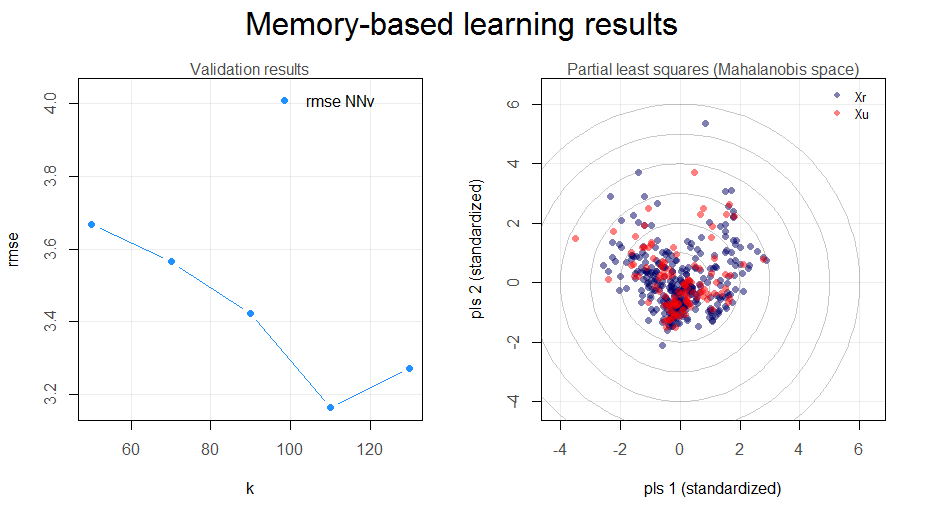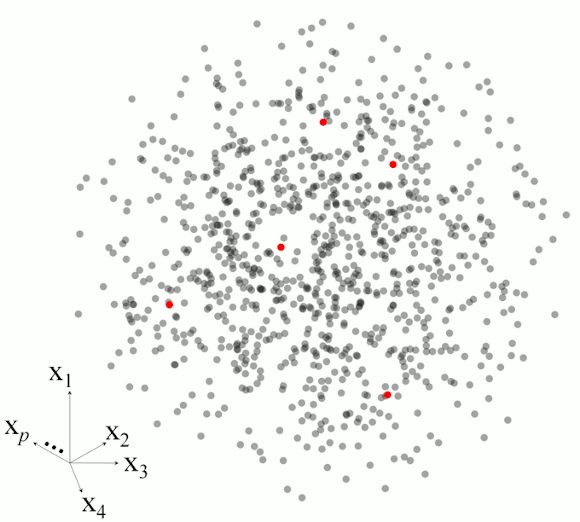The hardware and bandwidth for this mirror is donated by METANET, the Webhosting and Full Service-Cloud Provider.
If you wish to report a bug, or if you are interested in having us mirror your free-software or open-source project, please feel free to contact us at mirror[@]metanet.ch.
resemble
Memory-Based Learning in Spectral Chemometrics
Last update: 2025-10-17
Version: 2.2.5 – dstatements
Think Globally, Fit Locally (Saul and Roweis, 2003)
The resemble package provides high-performing
functionality for data-driven modeling (including local modeling),
nearest-neighbor search and orthogonal projections in spectral data.
A new vignette for resemble explaining its core
functionality is available at: https://cran.r-project.org/package=resemble/vignettes/resemble.html
The core functionality of the package can be summarized into the following functions:
mbl: implements memory-based learning
(MBL) for modeling and predicting continuous response variables. For
example, it can be used to reproduce the famous LOCAL algorithm proposed
by Shenk et al. (1997). In general, this function allows you to easily
customize your own MBL regression-prediction method.
dissimilarity: Computes dissimilarity
matrices based on various methods (e.g. Euclidean, Mahalanobis, cosine,
correlation, moving correlation, Spectral information divergence,
principal components dissimilarity and partial least squares
dissimilarity).
ortho_projection: A function for
dimensionality reduction using either principal component analysis or
partial least squares (a.k.a projection to latent structures).
search_neighbors: A function to
efficiently retrieve from a reference set the k-nearest neighbors of
another given dataset.
During the recent lockdown we invested some of our free time to come
up with a new version of our package. This new resemble 2.0
comes with MAJOR improvements and new functions! For these improvements
major changes were required. The most evident changes are in the
function and argument names. These have been now adapted to properly
follow the tydiverse style
guide. A number of changes have been implemented for the sake of
computational efficiency. These changes are documented in
inst\changes.md.
New interesing functions and fucntionality are also available, for
example, the mbl() function now allows sample spiking,
where a set of reference observations can be forced to be included in
the neighborhhoods of each sample to be predicted. The
serach_neighbors() function efficiently retrieves from a
refence set the k-nearest neighbors of another given dataset. The
dissimilarity() function computes dissimilarity matrices
based on various metrics.
If you want to install the package and try its functionality, it is
very simple, just type the following line in your R
console:
install.packages('resemble')If you do not have the following packages installed, it might be good to update/install them first
install.packages('Rcpp')
install.packages('RcppArmadillo')
install.packages('foreach')
install.packages('iterators')Note: Apart from these packages we stronly recommend
to download and install Rtools https://cran.r-project.org/bin/windows/Rtools/). This is
important for obtaining the proper C++ toolchain that might be needed
for resemble.
Then, install resemble
You can also install the development version of resemble
directly from github using devtools:
devtools::install_github("l-ramirez-lopez/resemble")NOTE: in some MAC Os it is still recommended to install
gfortran and clang from here. Even for R
>= 4.0. For more info, check this issue.
After installing resemble you should be also able to run
the following lines:
library(resemble)
library(tidyr)
library(prospectr)
data(NIRsoil)
# Proprocess the data
NIRsoil <- NIRsoil[NIRsoil$CEC %>% complete.cases(),]
wavs <- as.numeric(colnames(NIRsoil$spc))
NIRsoil$spc_p <- NIRsoil$spc %>%
standardNormalVariate() %>%
resample(wavs, seq(min(wavs), max(wavs), by = 11)) %>%
savitzkyGolay(p = 1, w = 5, m = 1)
# split into calibration/training and test
train_x <- NIRsoil$spc_p[as.logical(NIRsoil$train), ]
train_y <- NIRsoil$CEC[as.logical(NIRsoil$train)]
test_x <- NIRsoil$spc_p[!as.logical(NIRsoil$train), ]
test_y <- NIRsoil$CEC[!as.logical(NIRsoil$train)]
# Use MBL as in Ramirez-Lopez et al. (2013)
sbl <- mbl(
Xr = train_x, Yr = train_y, Xu = test_x,
k = seq(50, 130, by = 20),
method = local_fit_gpr(),
control = mbl_control(validation_type = "NNv")
)
sbl
plot(sbl)
get_predictions(sbl)

Figure 1. Standard plot of the results of the
mbl function.
resemble
implements functions dedicated to non-linear modelling of complex
visible and infrared spectral data based on memory-based learning (MBL,
a.k.a instance-based learning or local modelling in the
chemometrics literature). The package also includes functions for:
computing and evaluate spectral dissimilarity matrices, projecting the
spectra onto low dimensional orthogonal variables, spectral neighbor
search, etc.
To expand a bit more the explanation on the mbl
function, let’s define first the basic input data:
Reference (training) set: Dataset with n reference samples (e.g. spectral library) to be used in the calibration of spectral models. Xr represents the matrix of samples (containing the spectral predictor variables) and Yr represents a response variable corresponding to Xr.
Prediction set : Dataset with m samples where the response variable (Yu) is unknown. However it can be predicted by applying a spectral model (calibrated by using Xr and Yr) on the spectra of these samples (Xu).
To predict each value in Yu, the mbl function takes each
sample in Xu and searches in Xr for its k-nearest neighbours
(most spectrally similar samples). Then a (local) model is calibrated
with these (reference) neighbours and it immediately predicts the
correspondent value in Yu from Xu. In the function, the
k-nearest neighbour search is performed by computing spectral
dissimilarity matrices between observations. The mbl
function offers the following regression options for calibrating the
(local) models:
'gpr': Gaussian process with linear
kernel.
'pls': Partial least squares.
'wapls': Weighted average partial least
squares (Shenk et al., 1997).
Figure 2 illustrates the basic steps in MBL for a set of five observations.

Figure 2. Example of the main steps in memory-based learning for predicting a response variable in five different observations based on set of p-dimesnional variables.
Simply type and you will get the info you need:
citation(package = "resemble")resemble2025.10: Summerauer et al.,
2025 used resemble for MBL modelling of soil
physico-chemical properties from infrared spectra across tropical
hillslopes in Eastern Africa. The study revealed severe soil degradation
and SOC losses (up to –69 %) following deforestation, with limited
recovery from Eucalyptus reforestation.
2025.05: Sun and Shi, 2025 introduced a local MBL-style strategy combining spectral and geographical similarity for SOC prediction from RGB, DRS, and Sentinel-2 data; local PLSR outperformed global models and maintained accuracy across scales.
2025.03: Breure et al.,
2025 published in Nature Communications:
resemble used to model NIR–soil property relations for
particulate and mineral-associated organic carbon across European
agricultural soils, enabling an EU-wide SOC risk index based on
effective MAOC capacity and observed SOC change.
2025.03: Purushothaman et al.,
2025 applied MBL (resemble) to BRDF-corrected AVIRIS-NG
hyperspectral data for predicting soil properties in India; BRDF
correction improved accuracy (R² up to 0.83) and reduced RMSE by up to
47 %, enabling 5 m mapping.
2025.03: Kohlmann et al., 2025 fused vis–NIR and MIR with SVMR to predict total organic C, biochar C and native SOC in loess soils; cited MBL as a localisation strategy alongside spiking for site-specific transferability.
2025.02: Adam & Jackisch (LfULG report; no
DOI). MIR-DRIFTS soil-C monitoring workflow, regional spectral library;
compared PLSR, Cubist and MBL (resemble). (Leave unlinked
or link to an institutional page if available.)
2025.01: Dai et al., 2025
used MBL and non-linear MBL (N-MBL) for POC and MAOC from VNIR in
Guangdong; local resemble models outperformed global ML
(Cubist, PLSR, RF).
2024.12: Asrat et al.,
2024 MBL (resemble) for local calibration sample
selection in the Moroccan Soil Spectral Library; improved prediction of
Olsen P, pH, CEC vs global PLSR.
2024.11: Dai et al., 2024 used VNIR lab and in-situ spectra from wheat–rice fields in SE China (n=202) to predict SOC, POC, MAOC; PLSR/MBL performed best (lab SOC R² up to 0.91), and EPO gave modest in-situ gains, indicating feasible in-situ monitoring under low soil moisture.
2024.10: Lippolis et al.,
2024 MBL (resemble) for high-throughput NIR prediction
of faba bean seed traits; compared with PLS, Elastic Net and
Bayes-B.
2024.09: Barbetti et al., 2024 MBL to detect SOC changes in long-term experiments using vis–NIR; R² up to 0.91; compared with Cubist, SVM and RF.
2024.09: Moloney et al., 2024 MBL with the NZ Soil Spectral Library for SOC, TN and pH in Tonga; supplementing with small local sets markedly improved accuracy.
2024.08: Sherman et al., 2024 MBL with NIR for non-destructive characterisation of silicate materials (geoarchaeology).
2023.11: Wang et al., 2023 N-MBL (MBL + RF within local fitting) improved regional vis–NIR models for SOM, TN, TP vs MBL/PLSR/Cubist/SVM/CNN.
2023.04: Zhao et al., 2023
used MBL (resemble) + compositional data analysis to
quantify soil properties relevant to SOC biogeochemical cycles from IR
spectra.
2022: Sanderman et al., 2022
evaluated transferability of large MIR spectral databases across
instruments; MBL via resemble.
2022: Dangal et al., 2022
improved soil carbon estimates; resemble used within the
workflow.
2022.01: Ng et al.,
2022 showed that “spiking” regional Vis–NIR libraries with local
samples does not outperform localized models. Using Australian soils,
they found that memory-based learning (MBL) yield better local SOC
predictions. They used resemble.
2021.12: Yu et al., 2022 MBL with External Parameter Orthogonalization for field prediction of soil properties.
2021.10: Ramirez-Lopez et al., 2021 MBL to predict soil properties in Africa.
2020.08: Charlotte Rivard’s MIR MBL tutorial: https://whrc.github.io/Soil-Predictions-MIR/
2020.04: Tsakiridis et al., 2020 used optimal principal-components dissimilarity with CNNs for simultaneous vis–NIR prediction.
2019.04: Tziolas et al., 2019 improved MBL for quantitative soil predictions using NIR + geographic information.
2019.03 & 2019.08: Tsakiridis et al.,
2019a, 2019b
compared ML methods for predictive soil spectroscopy; MBL
(resemble) highly competitive.
2020.01: Sanderman et al., 2020 MIR spectroscopy for prediction of soil health indicators in the United States; MBL and Cubist excelled.
2019.03: Ramirez-Lopez et al., 2019 used MBL in digital soil mapping (farm-scale vis–NIR); here MBL removed local calibration outliers.
2019.01: Dangal et al.,
2019 resemble for MIR modelling from a continental US
soil spectral library.
2019.03: Jaconi et al.,
2019 MBL (resemble) for national-scale NIR texture
predictions in Germany.
2018.12: Hong/Chen et al.,
2019 fractional-order derivatives + MBL (resemble)
improved NIR prediction of SOM in China.
2018.11: Rivera et al., 2018 — Frontiers in Plant Science (common beans). (If you keep this, link the article’s DOI from Frontiers; avoid Google Scholar.)
2018.07: Gholizadeh et al., 2018
soil-carbon modelling with resemble.
2018.01: Dotto et al.,
2018 MBL (resemble) for SOC prediction in
Brazil.
2017.11: Kopf et al., 2017 (KIT Scientific Publishing, OCM 2017 proceedings). (Conference chapter/book—use the publisher page if you want a link; the Google Books preview can trigger CRAN URL notes.)
2016.05: Clairotte et al., 2016 national-scale SOC from diffuse IR spectroscopy.
2016.04: Viscarra Rossel et al., 2016 memory-based learning applied to predict soil properties.
2016.04: Blog examples on resemble:
http://nir-quimiometria.blogspot.com/ (keep as plain
HTTP; it’s fine for CRAN).
2016.02: resemble on CRAN: https://CRAN.R-project.org/package=resemble
2016.01: resemble 1.2 submitted to
CRAN; development on GitHub.
2015.11: 1.2.0 prerelease; core routines moved to C++ via Rcpp for speed.
2015.11: 1.1.3 never released to CRAN due to performance refactor.
2014.10: 1.1.3 prerelease (website); pending CRAN at the time.
2014.06: Video on local calibrations: https://www.youtube.com/watch?v=7sCIEeNehgE
2014.03: First CRAN release of
resemble.
prospectr.You can send an e-mail to the package maintainer (ramirez.lopez.leo@gmail.com) or create an issue on github.
Lobsey, C. R., Viscarra Rossel, R. A., Roudier, P., & Hedley, C. B. 2017. rs-local data-mines information from spectral libraries to improve local calibrations. European Journal of Soil Science, 68(6), 840-852.
Ramirez-Lopez, L., Behrens, T., Schmidt, K., Stevens, A., Dematte, J.A.M., Scholten, T. 2013. The spectrum-based learner: A new local approach for modeling soil vis-NIR spectra of complex data sets. Geoderma 195-196, 268-279.
Saul, L. K., & Roweis, S. T. 2003. Think globally, fit locally: unsupervised learning of low dimensional manifolds. Journal of machine learning research, 4(Jun), 119-155.
Shenk, J., Westerhaus, M., and Berzaghi, P. 1997. Investigation of a LOCAL calibration procedure for near infrared instruments. Journal of Near Infrared Spectroscopy, 5, 223-232.
These binaries (installable software) and packages are in development.
They may not be fully stable and should be used with caution. We make no claims about them.